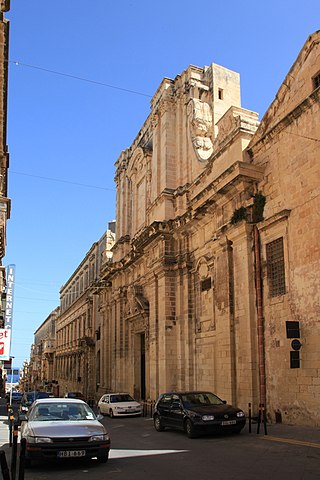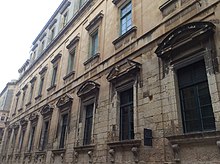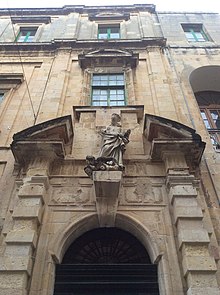
The University of Malta is a higher education institution in Malta. It offers undergraduate bachelor's degrees, postgraduate master's degrees and postgraduate doctorates. It is a member of the European University Association, the European Access Network, Association of Commonwealth Universities, the Utrecht Network, the Santander Network, the Compostela Group, the European Association for University Lifelong Learning (EUCEN) and the International Student Exchange Programme (ISEP).

The Collegium Hosianum was the Jesuit collegium founded in 1565, 1566 by Polish Cardinal Stanislaus Hosius in Braunsberg (Braniewo), Kingdom of Poland. The town was then part of the Polish Prince-Bishopric of Warmia under rule of Cardinal Hosius. The Collegium Hosianum was one of the biggest Jesuit schools and one of the most important centres of Counter-Reformation in Europe and was particularly established to educate Catholic clergy of different countries.

Msida is a harbour town in the Central Region of Malta with a population of 7,623 (2021).

Manuel Pinto da Fonseca was a Portuguese nobleman, the 68th Grand Master of the Order of Saint John, from 1741 until his death.

Henry Joseph Frendo is a professor of modern history, teaching at the University of Malta since 1992. Frendo has previously worked with the UNHCR, and was stationed in Switzerland, Mozambique, Zimbabwe, Egypt and Papua New Guinea. His main areas of research and interest are related to history since 1798; related to imperialism, nationalism, decolonization, postcolonialism, journalism, migration and ethnicity - in Central and Eastern Europe, the Mediterranean and MENA. Other areas of his interest are languages, culture and statehood.He is from Floriana and is brother of Michael Frendo.

Ġ.F. Abela Junior College, commonly known as the Junior College (JC), is a further education college in Msida, Malta, which prepares students for the Matriculation Certificate. It was established in 1995 by the University of Malta. It is named after the 17th-century Maltese historian Giovanni Francesco Abela.

The Pontifical Urban University, also called the Urbaniana after its names in both Latin and Italian, is a pontifical university under the authority of the Congregation for the Evangelization of Peoples. The university's mission is to train priests, religious brothers and sisters, and lay people for service as missionaries. Its campus is located on the Janiculum Hill in Rome, on extraterritorial property of the Holy See.

The Church of the Circumcision of Our Lord, also known as the Church of the Jesuits or the Church of the University, is one of the oldest and largest churches in Valletta, Malta. It was originally built between 1593 and 1609 by the Jesuit order, and it is located adjacent to the Old University Building, which originally housed a Jesuit college known as the Collegium Melitense. The church was rebuilt in the Baroque style by Francesco Buonamici after suffering extensive damage in an explosion in 1634. The church remained in use after the Jesuits were expelled from Malta in 1768, and it is also used for Masters and Doctoral graduation ceremonies of the University of Malta, the successor to the Collegium.

Education in Malta is compulsory through age sixteen and is offered through three different providers: the state, the church, and the private sector. The state is responsible for promoting education and instruction and ensuring universal access to education for all Maltese citizens the existence of a system of schools and institutions accessible to all Maltese citizens. The objectives of education in Malta include intellectual and moral development and the preparation of every citizen to contribute productively to the national economy. Although Maltese citizens had access to education during the Arab administration of 870 to 1090, the arrival of a number of religious orders in the following four centuries brought religious-based education to the island for wealthy families. The arrival of the Knights Hospitaller saw the establishment of the University of Malta, around which a number of primary, secondary and post-secondary institutions were established. Education in Malta has been universally available at the primary level since the ejection of the Knights Hospitaller by the French in 1798, when state-funded elementary schooling was established. In 1878, English replaced Italian as the primary language of instruction, and education was made compulsory in 1946 in response to a number of children not attending school due to poverty between World Wars One and Two. The age at which education became compulsory was lowered to five years in 1988
George Sagnani was a minor Maltese philosopher who specialized mainly in ethics and morals.

The Irish College at Salamanca,, it was endowed by the King of Spain and dedicated as the St Patrick’s Royal College for Irish Noblemen. It was founded by Thomas White, formerly of Clonmel, Ireland, in 1592 to house the students of that country who came to Salamanca to escape the religious persecution of the Catholic Church in Ireland. The students resided at the college while attending lectures at the University of Salamanca.

The Monte di Pietà, formerly known as the Monte di Sant'Anna, is a charitable institution which lends money to those in need at modest interest rates, on the security of gold, silver or other precious articles given in pawn. In Malta the institution was set up in 1598, was known in the British period as the Public Pawn-Brokery, and it is still in operation today as part of the Inland Revenue Department. Since 1773, the Monte di Pietà has been housed in a 16th-century building in Valletta.

On 12 September 1634, a Hospitaller gunpowder factory in Valletta, Malta accidentally blew up, killing 22 people and causing severe damage to a number of buildings. The factory had been built at some time in the late 16th or early 17th centuries, replacing an earlier one in Fort St. Angelo in Birgu. It was located in the lower part of Valletta, close to the Slaves' Prison.

The Old University Building, also known as the Valletta Campus, is the original campus of the University of Malta, located adjacent to the Church of the Jesuits in Valletta, Malta. Construction of the building began in 1595, and it originally housed a Jesuit college known as the Collegium Melitense Societatis Jesu. The building had to be repaired after being damaged in an explosion in 1634 and an earthquake in 1693.

Tomás Gargallo was a Spanish Roman Catholic prelate who became the Bishop of Malta in 1578.

The 1592–1593 Malta plague epidemic was a major outbreak of plague on the island of Malta, then ruled by the Order of St John. It occurred in three waves between June 1592 and September 1593, during the second plague pandemic, and it resulted in approximately 3000 deaths, which amounted to about 11% of the population. The disease was imported to Malta by Tuscan galleys that had captured vessels from Alexandria. In 1593, the Order requested assistance from Sicily to deal with the epidemic, and the measures taken were effective in containing plague.

The Church of Our Lady of Sorrows is a Roman Catholic church in Pietà, Malta. It was established in the late 16th or early 17th century near a cemetery in which victims of the 1592–1593 Malta plague epidemic were buried. It was originally dedicated to Saint Roch, but after a convent was built next to it in the early 17th century it was rededicated to Our Lady of Sorrows. The church later gave its name to the town of Pietà which developed nearby, and the present building dates back to the mid-18th century when it was reconstructed. Both the church and the convent are currently in the hands of a Catholic youth ministry.
Francesco Buonamici (1596–1677) was an Italian Baroque architect, painter and engraver who was active in Lucca, Malta, Sicily and Rome during the 17th century. He played a significant role in the introduction of Baroque in Malta.

The Mdina Cathedral Museum is a religious art museum located inside the mediaeval walled city of Mdina, Malta. The museum is housed within a Baroque building, that was built as a Jesuit seminary. It can be found on the right-hand side of the St. Paul's Cathedral, in Archbishop's Square. The museum's collection includes an eclectic secular and ecclesiastical repertoire. The museum also holds various artwork and archaeology remains, including important artwork by Mattia Preti. The museum also owns the most important collection of Italian Baroque music that has been preserved south of Naples.

















